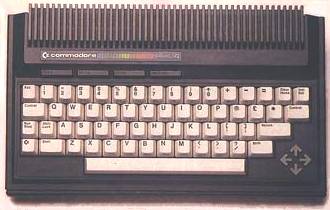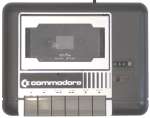
|
Manufacturer |
Commodore Business Machines (US) |
Model |
Plus/4 |
Date Launched |
June 1984 |
Price |
£250
Matching 1542 disk drive cost £220. |
Microprocessor type |
MOSTEK 7501 @ 0.89 to 1.76 MHz
The 7501 was a derivative of the 6502. Its clock speed depended on the graphics mode. |
ROM size |
52 kilobytes
(32KB for BASIC and 20KB for the applications.) |
Standard RAM |
64 kilobytes |
Maximum RAM |
64 kilobytes |
Keyboard type |
Full typewriter style with 4 function keys (across the top) and cursor arrows |
Supplied language |
Commodore BASIC 3.5 plus a machine code monitor.
Unlike the Commodore 64, the BASIC in the Plus/4 included graphics commands. |
Text resolution |
40 x 25 characters |
Graphics resolution |
160 x 200 or 320 x 200 pixels |
Colours available |
16 colours each at 8 brightnesses |
Sound |
Two channels plus noise |
Cassette load speed |
300 baud?
 Needed a special Commodore 1531 'datassette' unit (right) because the computer only outputted digital signals which the datassette converted to audio for recording. The 1531 was incompatible with the ones used for the VIC 20 and C64. Needed a special Commodore 1531 'datassette' unit (right) because the computer only outputted digital signals which the datassette converted to audio for recording. The 1531 was incompatible with the ones used for the VIC 20 and C64. |
Dimensions (mm)
Weight (grams) |
423 x 239 x 67
Not known |
Special features |
Supplied with four applications built into the ROM (hence Plus 4). These were a spreadsheet, word processor, graph generator and database. It was easy to transfer data among them. |
Good points |
Colourful display.
Large amount of available memory.
Small, neat styling. |
Bad points |
Due to hardware differences (e.g. the absence of 'sprite' graphics) the Plus/4 was unable to run the huge amount of software already written for the Commodore 64.
Sound quality was poorer than the C64's.
The built-in suite of applications was limited, e.g. the word processor could only handle a maximum of 99 lines of 77 characters and had no print preview, and the graph generator only produced bar charts composed of hash signs. |
How successful? |
The Plus/4 never really found a niche; it was withdrawn in 1985.
The Commodore Amiga, launched that year, was initially expensive but eventually achieved the aim of the Plus/4, becoming one of the most popular home/games machines. |
Comments |
The Plus/4 used a single custom chip to provide the video, sound and I/O, in order to make it cheaper to manufacture than the Commodore 64. The original design aim for the Plus/4 had been to produce a very low cost computer with similar abilities to the C64 but cheap enough to compete with the likes of the Sinclair Spectrum or Oric 1, and targeted more towards home office use than game playing.
The way the Plus/4 turned out though meant it cost £470 with the disk drive (which was needed to make full use of the in-built applications), putting it well beyond the Spectrum/Oric end of the market and up to the Sinclair QL bracket. However the Plus/4 was still an 8-bit computer with a fairly small memory and slow processor, and could not compete with the 16-bit machines which were becoming the standard for business applications.
Nor did the Plus/4 appeal to owners or potential purchasers of the Commodore 64 as an upgraded games console. It was £50 more expensive than the '64 and had virtually no games software, not helped by the absence of sprites and worse sound. Gamers were better off staying with the C64.
Not making the Plus/4 software-compatible with the Commodore 64 was definitely a mistake. In itself the Plus/4 was a competent computer, but why buy it when you could have the C64 with better graphics and sound and a vast array of software, for less money? |

